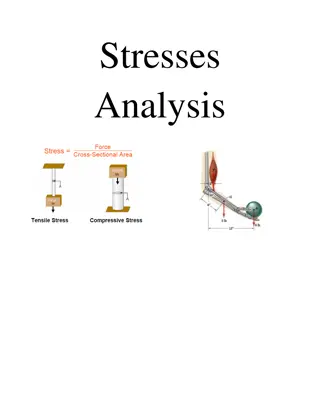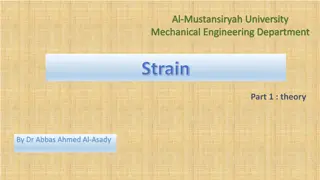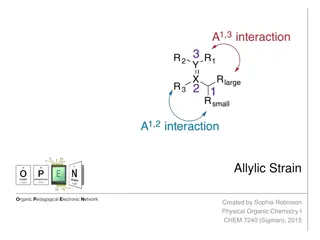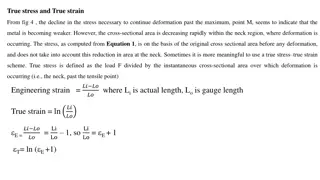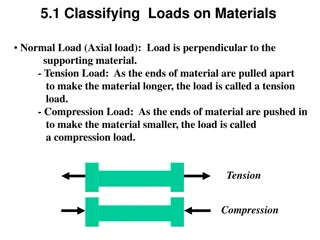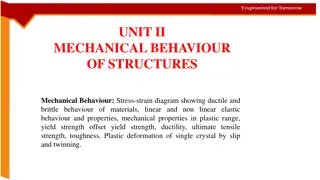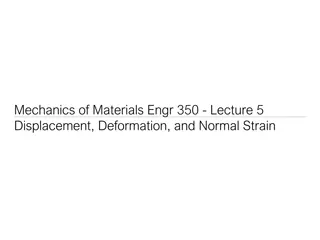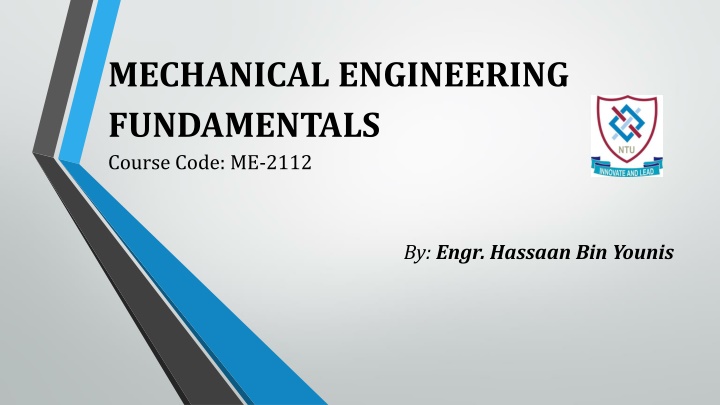
Mechanical Engineering Fundamentals - Loads, Stress, and Strain
Dive into the fundamentals of mechanical engineering, exploring the concepts of loads, stress, and strain. Learn about different types of loads, unit stress, unit strain, tensile and compressive stress and strain, shear stress and strain, as well as properties like Young's Modulus and Shear Modulus. Gain a comprehensive understanding of how external forces affect the behavior of materials in engineering applications.
Download Presentation

Please find below an Image/Link to download the presentation.
The content on the website is provided AS IS for your information and personal use only. It may not be sold, licensed, or shared on other websites without obtaining consent from the author. If you encounter any issues during the download, it is possible that the publisher has removed the file from their server.
You are allowed to download the files provided on this website for personal or commercial use, subject to the condition that they are used lawfully. All files are the property of their respective owners.
The content on the website is provided AS IS for your information and personal use only. It may not be sold, licensed, or shared on other websites without obtaining consent from the author.
E N D
Presentation Transcript
MECHANICAL ENGINEERING FUNDAMENTALS Course Code: ME-2112 By: Engr. Hassaan Bin Younis
LOAD Any external force acting upon a machine part. Types of the load: 1. Dead or steady load. A load is said to be a dead or steady load, when it does not change in magnitude or direction. 2. Live or variable load. A load is said to be a live or variable load, when it changes continually. 3. Suddenly applied or shock loads. A load is said to be a suddenly applied or shock load, when it is suddenly applied or removed. 4. Impact load. A load is said to be an impact load, when it is applied with some initial velocity
STRESS When some external system of forces or loads act on a body, the internal forces (equal and opposite) are set up at various sections of the body, which resist the external forces. This internal force per unit area at any section of the body is known as unit stress or simply a stress. It is denoted by a Greek letter sigma ( ). Mathematically, Stress, = P/A where P = Force or load acting on a body, and A = Cross-sectional area of the body.
STRAIN When a system of forces or loads act on a body, it undergoes some deformation. This deformation per unit length is known as unit strain or simply a strain. It is denoted by a Greek letter epsilon ( ). Mathematically, Strain, = l / l or l = .l where l = Change in length of the body, And l = Original length of the body.
STRESS & STRAIN Tensile Stress and Strain When a body is subjected to two equal and opposite axial pulls P (also called tensile load), then the stress induced at any section of the body is known as tensile stress. The ratio of the increase in length to the original length is known as tensile strain. Compressive Stress and Strain When a body is subjected to two equal and opposite axial pushes P (also called compressive load), then the stress induced at any section of the body is known as compressive stress. The ratio of the decrease in length to the original length is known as compressive strain. Shear Stress and Strain When a body is subjected to two equal and opposite forces acting tangentially across the resisting section, as a result of which the body tends to shear off the section, then the stress induced is called shear stress. The corresponding strain is known as shear strain
STRESS & STRAIN Young's Modulus or Modulus of Elasticity When a material is loaded within elastic limit, the stress is directly proportional to strain, i.e. or = E. where E is a constant of proportionality known as Young's modulus or modulus of elasticity Shear Modulus or Modulus of Rigidity It has been found experimentally that within the elastic limit, the shear stress is directly proportional to shear strain. Mathematically or = C . or / = C
STRESS & STRAIN Stress-strain Diagram Proportional limit 1. Elastic limit 2. Yield point 3. Ultimate stress 4. Breaking stress 5. Percentage reduction in area 6. Percentage elongation 7.
STRESS & STRAIN Working Stress When designing machine parts, it is desirable to keep the stress lower than the maximum or ultimate stress at which failure of the material takes place. This stress is known as the working stress or design stress. It is also known as safe or allowable stress. Factor of Safety It is defined, in general, as the ratio of the maximum stress to the working stress. Mathematically For Ductile materials For Brittle materials
Selection of Factor of Safety 1. The reliability of the properties of the material and change of these properties during service 2. The reliability of test results and accuracy of application of these results to actual machine parts 3. The reliability of applied load 4. The certainty as to exact mode of failure 5. The extent of simplifying assumptions 6. The extent of localised stresses 7. The extent of initial stresses set up during manufacture 8. The extent of loss of life if failure occurs 9. The extent of loss of property if failure occurs.




